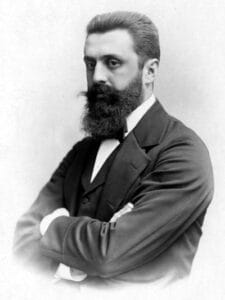By GIL TROY
(Jewish Journal via JNS)
Editor’s note: Excerpted from the new three-volume set, Theodor Herzl: Zionist Writings, the inaugural publication of The Library of the Jewish People edited by Gil Troy, marking the 125th anniversary of the First Zionist Congress.
An event marking the 125th anniversary of the First Zionist Congress concluded Monday night, Aug. 29, in Basel, Switzerland with a gala ceremony that brought together more than 1,400 delegates from 40 countries.

THEODOR HERZL, 1897 Photo courtesy of the public domain.
Intersection Of Assimilation
Theodor Herzl was born on May 2, 1860, in Pest, Hungary, across the River Danube from Buda. The second child and only son of a successful businessman, Jakob, he was raised to fit in to the elegant, sophisticated society his family and a fraction of his people had fought so hard to enter. But it is too easy to caricature his upbringing as fully emancipated and assimilated.
His paternal grandfather, Simon Loeb Herzl, came from Semlin, today’s Zemun, now incorporated into Belgrade. There, Simon befriended Rabbi Judah ben Solomon Chai Alkalai. This prominent Sephardic leader was an early Zionist, scarred by the crude anti-Semitism of the Damascus Blood Libel of 1840, inspired by the old-new Greek War of Independence in the 1820s—and energized by the spiritual and agricultural possibilities of returning the Jews to their natural habitat, their homeland in the Land of Israel. It is plausible that the grandfather conveyed some of those ideas, some of that excitement, to his grandson.
Still, the move from Semlin to Budapest, from poverty to wealth, from intense Jewish living in the ghetto to emancipated European ways in the city, placed the Herzl family at the intersection of many of his era’s defining currents.
The 1800s were years of change—and of isms. Creative ideas erupted amid the disruptions of industrialization, urbanization and capitalism. Three defining ideologies were rationalism, liberalism and nationalism—with each one shaping the next. The Age of Reason, the Enlightenment—science itself—rose thanks to rationalism. Life was no longer organized around believing in God and serving your king, but following logic, facts, objective truth. The logic of reason flowed naturally to liberalism, an expansive political ideology rooted in recognizing every individual’s inherent rights. Finally, as polities became less God-and-king-centered, nationalism filled in the God-sized hole in many people’s hearts. Individuals bonded based on their common heritage, language, ethnicity, or regional pride—and needs.
Ideological Clashes
Ideas are not static. In an ideological age rippling with such dramatic changes, the different isms kept colliding and fusing, like atoms becoming molecular compounds. Some combinations proved more stable—and constructive—than others.
Liberalism combined with nationalism created Americanism, the democratic model wherein individual rights flourished in a collective context yielding the liberal-democratic nation-state. An offshoot of liberalism emphasizing equality more than rights fused with rationalism and created Marxism, although Karl Marx admitted his theories could only be enacted with irrational terror. Marxism with that violent streak, drained of liberalism, became communism, while a hyper-nationalism, rooted in blood-and-soil loyalty, and the kind of Marxist rationalism and totalitarianism also drained of any liberalism, created Nazism.
A similar impressionistic summary of the Jewish experience would track how the nineteenth century’s ideological clashes shaped the major movements and institutions still defining Judaism, from the Reform movement to Zionism, from the modern synagogue to the State of Israel. Judaism and rationalism set off the explosion of scholarship—the Wissenschaft—while Judaism mixed with liberalism triggered the Reform and Conservative movements’ theological inventiveness. In response, ultra-Orthodoxy emerged, hostile to change—essentially subtracting liberalism from Judaism. Modern Orthodoxy synthesized, accepting some liberalism in Judaism and eventually Jewish nationalism without too much rationalism. And, thanks to Herzl and others, the compound of Judaism and liberalism and nationalism yielded Zionism.
Fighting Stereotypes
The actual historical process was much messier. It began with the great double-edged sword of European Emancipation. First in the West, then in the East, some Europeans welcomed Jews with equal rights and extraordinary opportunities, liberating many to move to the cities—and for a few to succeed on legendary scales. Moses Mendelssohn (1729–1786), the Herzl of the Haskala—Enlightenment—was a Jew who as a philosopher dazzled Berlin. But, unlike Herzl, Mendelssohn was so fluent in Judaism and Hebrew that in 1783 he started translating much of the Bible into High German, adding commentary sporadically too. Mendelssohn epitomized the Haskala ideal of being a full, functioning, literate Jew in the house and a full, functioning, popular man on the street. And, unlike Herzl, Mendelssohn was ugly, infamously so, a walking ghetto stereotype with his crooked back and hooked nose.
Mendelssohn was accepted. Jews, however, realized that Europe’s embrace often came at a cost: Jews had to be willing to give up their Jewishness, to fit in so much that many lost their way. Mendelssohn had six children who survived into adulthood—only two remained Jewish. Most disturbing, the Jewish rush into modern European society triggered a backlash, an updated, racist Jew-hatred that became increasingly potent as nationalist demagogues blamed the era’s problems on Europe’s traditional scapegoat, the Jews.
Rather than being welcomed smoothly into European life, most Jews felt mugged by modernity. The complex realities never matched the euphoric hopes of the maskilim, the Enlightened Reformers, that their people would “awake” from their ghetto-imposed long “slumber,” as the Russian-Jewish maskil Y. L. Gordon would write in Hebrew in 1866.
Developing Mendelssohn’s vision as the pioneering Jewish modernizer, Gordon celebrated the essential bargain Jews like Theodor and his parents accepted. The deal was: “Be a man when you wander outside and a Jew when at home.” In Herzl’s household—like so many other bourgeois Jewish homes—the success in looking normal on the streets came at a high Jewish cost, even at home.
For Herzl and his family, Middle European Jews caught in the middle, every educational choice became a marker. Were you looking backward to your traditional past or forward to your enlightened future? Initially, Herzl’s parents, Jakob and Jeannette née Diamant, tried doing both. When their son was eight days old, they initiated their son Theodor into the great identity juggle by giving him a Hebrew name—Binyamin Ze’ev.
Ultimately, then, Binyamin Ze’ev Herzl was far more rooted in Judaism—and the Jewish struggle of the nineteenth century, than most legends acknowledge.
Prof. Gil Troy is the author of The Zionist Ideas and the editor of the three-volume set Theodor Herzl: Zionist Writings, the inaugural publication of the Library of the Jewish People, to be published this August marking the 125th anniversary of the First Zionist Congress.This article was originally published by The Jewish Journal.








